The Air Bubble Bags Market is estimated to be valued at USD 1261.7 million in 2025 and is projected to reach USD 1865.8 million by 2035, registering a compound annual growth rate (CAGR) of 4.0% over the forecast period.
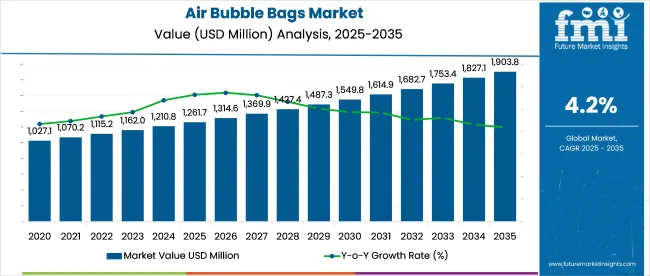
| Metric | Value |
|---|---|
| Air Bubble Bags Market Estimated Value in (2025 E) | USD 1261.7 million |
| Air Bubble Bags Market Forecast Value in (2035 F) | USD 1865.8 million |
| Forecast CAGR (2025 to 2035) | 4.0% |
The air bubble bags market is witnessing strong momentum as industries increasingly focus on protective packaging solutions that balance durability, lightweight properties, and cost efficiency. Rising e commerce volumes, global trade expansion, and stricter product safety standards have heightened the demand for reliable cushioning materials.
Plastic based air bubble bags continue to dominate due to their superior protective qualities, adaptability across product categories, and compatibility with automated packaging systems. Regulatory scrutiny on single use plastics is simultaneously driving innovation in recyclable and reusable plastic blends, allowing manufacturers to align with sustainability mandates.
The outlook remains positive with consistent adoption in food, electronics, and healthcare supply chains where damage prevention, compliance, and operational efficiency are critical drivers.
The plastic air bubble bags material segment is expected to represent 49.60% of total market revenue by 2025, making it the dominant choice in this category. This is primarily due to its strong cushioning properties, flexibility in packaging design, and ability to protect goods during transit.
Plastic air bubble bags have also been favored for their cost effectiveness and scalability in mass production. Continuous advancements in recyclable plastics and biodegradable additives are further supporting their adoption across environmentally conscious industries.
As demand for secure packaging rises in e commerce and logistics, plastic air bubble bags continue to secure leadership in the material segment.
The slider closure type segment is projected to account for 53.20% of the total market revenue by 2025, positioning it as the leading closure method. Its dominance is supported by ease of use, enhanced resealability, and the ability to maintain product integrity during multiple handling cycles.
The slider mechanism provides consumers and businesses with convenience while ensuring secure closure, which is particularly important in food, medical, and retail packaging.
The preference for user friendly and tamper evident closure types has reinforced the market leadership of slider based solutions within the air bubble bags category.
The food industry segment is estimated to contribute 47.80% of market revenue by 2025 under the end use category, making it the most prominent application. Growth in this segment is being driven by the increasing need to protect perishable and fragile food items during transportation and storage.
Air bubble bags offer superior cushioning, minimize contamination risks, and extend the shelf life of packaged products. Their widespread use in both retail and wholesale food distribution has been further supported by rising consumer demand for safe and hygienic packaging.
With food safety regulations becoming more stringent, the adoption of air bubble bags in the food industry continues to strengthen, ensuring their position as the leading end use segment.
The global demand for air bubble bags is projected to increase at a CAGR of 4.2% during the forecast period between 2025 and 2035, reaching a total of USD 1,753.41 million in 2035, according to a report from Future Market Insights (FMI). From 2020 to 2025, sales witnessed significant growth, registering a CAGR of 3.3%.
Packaging is an important aspect of product distribution. They aid with the protection of the product during storage and transit. Air bubble bags are a form of packaging used to protect items from external harm such as moisture or rust.
They are used in packaging various things like health supplements, food, and electrical components. The growth of the air bubble bags market is majorly determined by technological improvements, rising disposable income, and fast industrialization and urbanization.
The increased use of air bubble bags in the food and beverage and pharmaceutical industries is considerably driving market expansion.
The air bubble bag uses less material and protects the material from external harm. These characteristics make them a highly sought-after commodity on the market. Air bubble bags are in high demand for online purchases. This has an even greater impact on market expansion.
However, government laws surrounding the use of plastic, high costs, and the availability of replacements such as heat seal bags may stymie market expansion.
Growing Usage of Air Bubble Bags across Various End-Use Industries to Widen Growth Prospects
The air bubble bags market is advancing technologically due to rising urbanization and industrialization. The growing usage of air bubble bags in the pharmaceutical, food, and beverage industries is likely to boost the worldwide air bubble bags market significantly.
Air bubble bags market sales are also driven by their excellent performance during transit and storage, as well as their ability to protect sensitive items and components from moisture, corrosion, and shielding.
The use of void-fill materials allows the air bubble bag industry to acquire a competitive edge over alternative fill materials in terms of cost-effectiveness and material utilization.
The growing popularity of contemporary retail due to its versatility and rising disposable income among customers worldwide supports the expansion of the air bubble bags industry.
Strict Government Laws and Regulations Governing the Usage of Plastic to Impede Market Growth
Despite the fact that the air bubble bags market offers multiple end-uses, there are numerous barriers to market expansion. Other options, such as paper packaging, may impede the expansion of the air bubble bag business.
The strict government laws and regulations governing the usage of plastic are projected to hinder the expansion of the air bubble bags industry in the coming year. With ever-increasingly complicated laws and restrictions, air bubble bag manufacturers are concentrating on developing unique and novel goods.
Furthermore, the high cost of air bubble bag packaging is viewed as a barrier to expanding the air bubble bag business. Additionally, the use of heat seal bags is predicted to slow the creation of air bubbles.
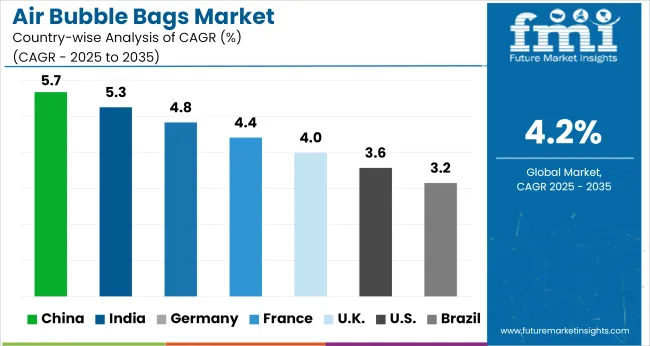
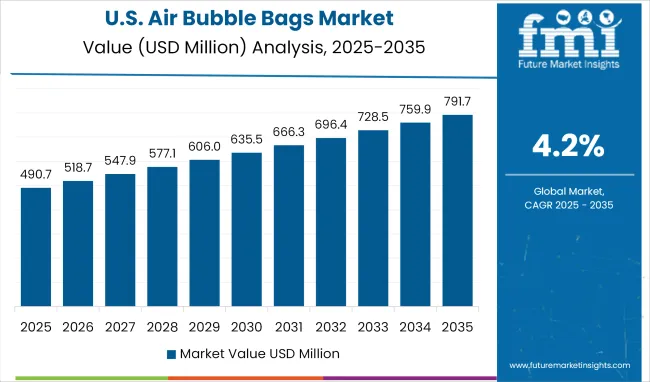
The Rising Demand for Air Bubble Bags for Industrial Applications to Push Sales
North America was the biggest market for air bubble bags, and this trend is projected to continue throughout the forecast period due to the region's significant manufacturing of air bubble bags.
The rising demand for air bubble bags for industrial applications is projected to boost the air bubble bag market. North America accounts for 24% of the overall market share of the worldwide air bubble bags market.
During the projection period, North America is predicted to be the next leading area, with strong adoption rates for air bubble bags. With the fast development and expansion of goods transportation in North America, the region's need for air bubble bags is expected to expand.
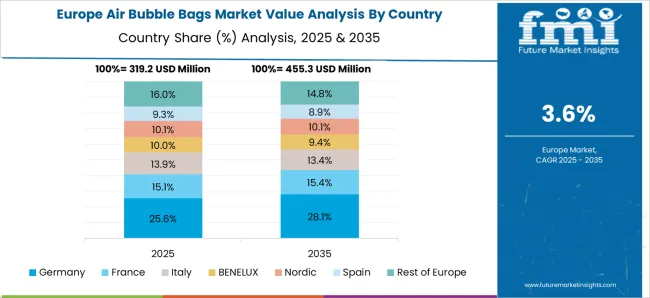
Europe's Booming E-Commerce and Packaging Industries to Drive Market Growth
According to Future Market Insights, Europe will give enormous development prospects for the air bubble bags market due to the region's booming e-commerce and packaging industries.
The air bubble bags market is predicted to increase steadily throughout the forecast period. The rising demand for consumer products is driving the expansion of the air bubble bags market. Europe accounts for 32% of the global market for air bubble bags.
Increasing Demand for Electronics to Push Market Sales
The food industry, pharmaceutical industry, gifts, mailing, garbage use, industrial goods, automotive products, electronics, and other end users are the end-use industries. Electronics is anticipated to have the biggest market share, followed by pharmaceutical.
Continuous R&D spending by market participants in the creation of new electronic devices with increased features will drive global air bubble bags industry growth. Philips, for example, spent USD 1213.2 million on R&D operations in the first quarter of 2024.
Through its Innovation 2025 transformation initiative, Philips spends heavily on R&D and innovation.
Electronics will rise as a result of aggressive R&D spending and regional development to fulfill rising consumer demand. Because of the advent of new technology, the industry is one of the fastest-growing industries. Rapid technological improvements to meet customer preferences will provide market possibilities throughout the projected period.
The market development will be aided by the market trend of incorporating MicroLED technology into televisions for high-resolution density, further driving the demand for global air bubble bags market.
Growing Packaging Industry to Drive Demand
Slider zippers are frequently used in the main packaging. Slider zippers aid in strengthening the main packaging, which helps to keep and protect the package's ingredients from contamination and harm. Slider technology makes use of a tiny sliding element that aids in the opening and closing of the box.
Aside from being lightweight, these slider zippers for packaging ensure that the package's contents are totally sealed off from the environment. Slider zippers are simply installed in plastic pouches and other packaging types. The package forms benefit from the addition of a slider zipper. Slider zippers are also handy for packing items or commodities that require frequent access.
Their resolvability adds only a modest cost to the package while increasing the perceived value greatly. Additionally, slider zippers for packing increase simplicity, portability, and single-handed use. Hence, the slider zipper segment is anticipated to grow at the highest CAGR during the forecast period.
Key startup players in the Air Bubble Bags market are:
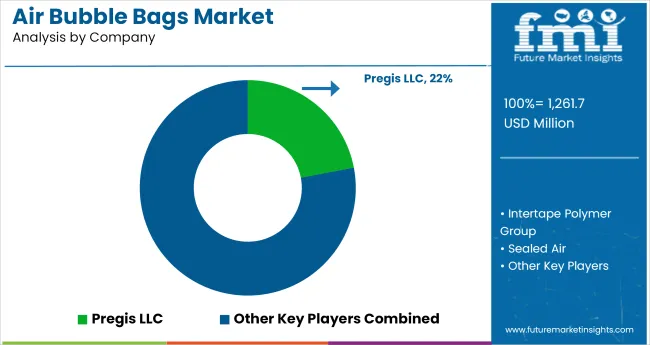
Amcor Limited, Bemis Company Inc., Berry Plastics, Sealed Air Corporation, Wipak Group, Mondi Group, Wenzhou Chuangjia Packing Material Co., Ltd., Dongguan OK Packaging Manufacturing Co., Ltd., Cangnan Kanghui Packaging Co., Ltd., and Shenzhen Rishanhong Plastic Packaging Products Co., Ltd. are some of the key players in the global air bubble bags market.
Because of the large number of competitors, the market is extremely competitive. While global manufacturers such as Amcor Limited, Bemis Company Inc., Berry Plastics, Sealed Air Corporation, Wipak Group, and Mondi Group account for a sizable share of the market, various regional-level firms are also active in key development regions, notably Asia Pacific.
Recent Developments in the Global Air Bubble Bags Market:
| Report Attribute | Details |
|---|---|
| Growth Rate | CAGR of 4.2% from 2025 to 2035 |
| Market Value in 2025 | USD 1261.7 million |
| Market Value in 2035 | USD 1865.8 million |
| Base Year for Estimation | 2025 |
| Historical Data | 2020 to 2025 |
| Forecast Period | 2025 to 2035 |
| Quantitative Units | Revenue in USD million and CAGR from 2025 to 2035 |
| Report Coverage | Revenue Forecast, Volume Forecast, Company Ranking, Competitive Landscape, Growth Factors, Trends and Pricing Analysis |
| Segments Covered | Material, Closure Type, End Use, Region |
| Regions Covered | North America; Latin America; Europe; East Asia; South Asia; Oceania; Middle East and Africa |
| Key Countries Profiled | United States, Canada, Brazil, Mexico, Argentina, Chile, Peru, Germany, Italy, France, UK, Spain, BENELUX, Nordic, Russia, Poland, China, Japan, South Korea, India, Thailand, Indonesia, Malaysia, Australia, New Zealand, GCC, Turkey, South Africa |
| Key Companies Profiled | Pregis LLC; Intertape Polymer Group; Sealed Air; Smurfit Kappa; Mondi Group; Jiffy Packaging Co.; Barton Jones Packaging; Abco Kovex; Future Packaging; iVEX Packaging; Dongguan OK Packaging Manufacturing Co. Ltd.; Desco Europe; PH Flexible; Makkipak Ltd. |
| Customization | Available Upon Request |
The global air bubble bags market is estimated to be valued at USD 1,261.7 million in 2025.
The market size for the air bubble bags market is projected to reach USD 1,865.8 million by 2035.
The air bubble bags market is expected to grow at a 4.0% CAGR between 2025 and 2035.
The key product types in air bubble bags market are plastic air bubble bags, aluminum foil air bubble bags, paper air bubble bags and paperboard air bubble bags.
In terms of closure type, slider segment to command 53.2% share in the air bubble bags market in 2025.






Full Research Suite comprises of:
Market outlook & trends analysis
Interviews & case studies
Strategic recommendations
Vendor profiles & capabilities analysis
5-year forecasts
8 regions and 60+ country-level data splits
Market segment data splits
12 months of continuous data updates
DELIVERED AS:
PDF EXCEL ONLINE
Understanding Market Share Trends in the Air Bubble Bags Industry
Aircraft Flight Control System Market Size and Share Forecast Outlook 2025 to 2035
Airborne Radar Market Size and Share Forecast Outlook 2025 to 2035
Aircraft Electric Motor Market Forecast Outlook 2025 to 2035
Airport Ground Transportation Market Forecast and Outlook 2025 to 2035
Airless Sprayer Accessories Market Size and Share Forecast Outlook 2025 to 2035
Air Purge Valve Market Size and Share Forecast Outlook 2025 to 2035
Air Flow Sensors Market Size and Share Forecast Outlook 2025 to 2035
Air Separation Plant Market Size and Share Forecast Outlook 2025 to 2035
Air Cooled Turbo Generators Market Size and Share Forecast Outlook 2025 to 2035
Aircraft Cooling Turbines Market Size and Share Forecast Outlook 2025 to 2035
Air Conditioning Compressor Market Size and Share Forecast Outlook 2025 to 2035
Air Measuring Equipment Market Size and Share Forecast Outlook 2025 to 2035
Aircraft Smoke Detection and Fire Extinguishing System Market Size and Share Forecast Outlook 2025 to 2035
Aircraft Hose Fittings Market Size and Share Forecast Outlook 2025 to 2035
Aircraft Cabin Interior Market Size and Share Forecast Outlook 2025 to 2035
Aircraft Galley Systems Market Size and Share Forecast Outlook 2025 to 2035
Aircraft Interior Lighting Market Size and Share Forecast Outlook 2025 to 2035
Aircraft Battery Market Size and Share Forecast Outlook 2025 to 2035
Aircraft Floor Panels Market Size and Share Forecast Outlook 2025 to 2035

Thank you!
You will receive an email from our Business Development Manager. Please be sure to check your SPAM/JUNK folder too.
Chat With
MaRIA